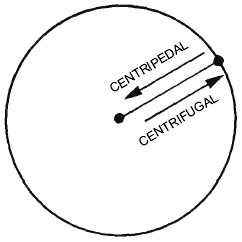line and with the same speed unless acted upon by some
external force. Therefore, for a body to move in a
curved path, some force must be continually applied.
The force restraining bodies that move in a curved path
is called the centripetal force; it is always directed
toward the center of rotation. When a rock is whirled
around on a string, the centripetal force is afforded by
the tension of the string.
Newton’s third law states that for every action there
is an equal and opposite reaction. Centrifugal force is
the reacting force that is equal to and opposite in
direction to the centripetal force. Centrifugal force,
then, is a force directed outward from the center of
rotation.
As you know, a bucket of water can be swung over
your head at a rate of speed that allows the water to
remain in the bucket. This is an example of both
centrifugal and centripetal force. The water is held in
the bucket by centrifugal force tending to pull it
outward. The centripetal force, the force holding the
bucket and water to the center, is your arm swinging the
bucket. As soon as you cease swinging the bucket, the
forces cease and the water falls out of the bucket. Figure
3-10 is a simplified illustration of centripetal and
centrifugal force.
High- and low-pressure systems can be compared
to rotating discs. Centrifugal effect tends to fling air out
from the center of rotation of these systems. This force
is directly proportional to the wind speeds, the faster the
wind, and the stronger the outward force. Therefore,
when winds tend to blow in a circular path, centrifugal
effect (in addition to pressure gradient and Coriolis
effects) influences these winds.
Frictional Force
The actual drag or slowing of air particles in
contact with a solid surface is called friction. Friction
tends to retard air movement. Since Coriolis force
varies with the speed of the wind, a reduction in the
wind speed by friction means a reduction of the
Coriolis force. This results in a momentary disruption
of the balance. When the new balance (including
friction) is reached, the air flows at an angle across the
isobars from high pressure to low pressure. (Pressure
gradient force is the dominant force at the surface.) This
angle varies from 10 degrees over the ocean to more
than 45 degrees over rugged terrain. Frictional effects
on the air are greatest near the ground, but the effects
are also carried aloft by turbulence. Surface friction is
effective in slowing the wind to an average altitude of
2,000 feet (about 600 meters) above the ground. Above
this level, called the gradient wind level or the second
standard level the effect of friction decreases rapidly
and may be considered negligible. Air above 2,000 feet
normally flows parallel to the isobars.
WIND TYPES
Since there is a direct relationship between
pressure gradient and wind speed and direction, we
have a variety of wind types to deal with. We discuss
below the relationship of winds and circulations, the
forces involved, and the effect of these factors on the
general circulation.
Geostrophic and Gradient Wind
On analyzed surface weather charts, points of equal
pressure are connected by drawn lines referred to as
isobars, while in upper air analysis, points of equal
heights are connected and called isoheights.
The variation of these heights and pressures from
one locality to another is the initial factor that produces
movement of air, or wind. Assume that at three stations
the pressure is lower at each successive point. This
means that there is a horizontal pressure gradient (a
decrease in pressure in this case) for each unit distance.
With this situation, the air moves from the area of
greater pressure to the area of lesser pressure.
If the force of the pressure were the only factor
acting on the wind, the wind would flow from high to
low pressure, perpendicular to the isobars. Since
experience shows the wind does not flow perpendicular
to isobars, but at a slight angle across them and towards
the lower pressure, it is evident that other factors are
3-10
AG5f0310
Figure 3-10.—Simplified illustration of centripetal and
centrifugal force.


